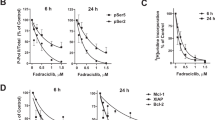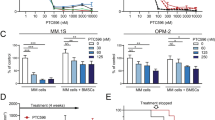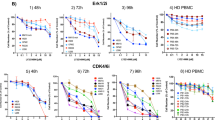Abstract
Cyclin D dysregulation and overexpression is noted in the majority of multiple myeloma (MM) patients, suggesting its critical role in MM pathogenesis. Here, we sought to identify the effects of targeting cyclin D in MM. We first confirmed cyclin D mRNA overexpression in 42 of 64 (65%) patient plasma cells. Silencing cyclin D1 resulted in >50% apoptotic cell death suggesting its validity as a potential therapeutic target. We next evaluated P276-00, a clinical-grade small-molecule cyclin-dependent kinase inhibitor as a way to target the cyclins. P276-00 resulted in dose-dependent cytotoxicity in MM cells. Cell-cycle analysis confirmed either growth arrest or caspase-dependent apoptosis; this was preceded by inhibition of Rb-1 phosphorylation with associated downregulation of a range of cyclins suggesting a regulatory role of P276-00 in cell-cycle progression through broad activity. Proliferative stimuli such as interleukin-6, insulin-like growth factor-1 and bone-marrow stromal cell adherence induced cyclins; P276-00 overcame these growth, survival and drug resistance signals. Because the cyclins are substrates of proteasome degradation, combination studies with bortezomib resulted in synergism. Finally, in vivo efficacy of P276-00 was confirmed in an MM xenograft model. These studies form the basis of an ongoing phase I study in the treatment of relapsed/refractory MM.
This is a preview of subscription content, access via your institution
Access options
Subscribe to this journal
Receive 12 print issues and online access
$259.00 per year
only $21.58 per issue
Buy this article
- Purchase on Springer Link
- Instant access to full article PDF
Prices may be subject to local taxes which are calculated during checkout







Similar content being viewed by others
Accession codes
References
Hideshima T, Bergsagel PL, Kuehl WM, Anderson KC . Advances in biology of multiple myeloma: clinical applications. Blood 2004; 104: 607–618.
Hideshima T, Mitsiades C, Tonon G, Richardson PG, Anderson KC . Understanding multiple myeloma pathogenesis in the bone marrow to identify new therapeutic targets. Nat Rev Cancer 2007; 7: 585–598.
Jemal A, Siegel R, Ward E, Hao Y, Xu J, Murray T et al. Cancer statistics, 2008. CA Cancer J Clin 2008; 58: 71–96.
Raje N, Anderson K . Thalidomide—a revival story. N Engl J Med 1999; 341: 1606–1609.
Singhal S, Mehta J, Desikan R, Ayers D, Roberson P, Eddlemon P et al. Antitumor activity of thalidomide in refractory multiple myeloma. N Engl J Med 1999; 341: 1565–1571.
Richardson PG, Barlogie B, Berenson J, Singhal S, Jagannath S, Irwin D et al. A phase 2 study of bortezomib in relapsed, refractory myeloma. N Engl J Med 2003; 348: 2609–2617.
Richardson PG, Sonneveld P, Schuster MW, Irwin D, Stadtmauer EA, Facon T et al. Bortezomib or high-dose dexamethasone for relapsed multiple myeloma. N Engl J Med 2005; 352: 2487–2498.
Raje N, Hideshima T, Anderson KC . Therapeutic use of immunomodulatory drugs in the treatment of multiple myeloma. Expert Rev Anticancer Ther 2006; 6: 1239–1247.
Harousseau JL, Moreau P . Evolving role of stem cell transplantation in multiple myeloma. Clin Lymphoma Myeloma 2005; 6: 89–95.
Kumar SK, Rajkumar SV, Dispenzieri A, Lacy MQ, Hayman SR, Buadi FK et al. Improved survival in multiple myeloma and the impact of novel therapies. Blood 2008; 111: 2516–2520.
Bergsagel PL, Kuehl WM, Zhan F, Sawyer J, Barlogie B, Shaughnessy Jr J . Cyclin D dysregulation: an early and unifying pathogenic event in multiple myeloma. Blood 2005; 106: 296–303.
Bergsagel PL, Kuehl WM . Molecular pathogenesis and a consequent classification of multiple myeloma. J Clin Oncol 2005; 23: 6333–6338.
Shaughnessy Jr JD, Barlogie B . Using genomics to identify high-risk myeloma after autologous stem cell transplantation. Biol Blood Marrow Transplant 2006; 12: 77–80.
Kuehl WM, Bergsagel PL . Early genetic events provide the basis for a clinical classification of multiple myeloma. Am Soc Hematol Educ Program 2005, 346–352.
Agnelli L, Bicciato S, Mattioli M, Fabris S, Intini D, Verdelli D et al. Molecular classification of multiple myeloma: a distinct transcriptional profile characterizes patients expressing CCND1 and negative for 14q32 translocations. J Clin Oncol 2005; 23: 7296–7306.
Fonseca R, Bailey RJ, Ahmann GJ, Rajkumar SV, Hoyer JD, Lust JA et al. Genomic abnormalities in monoclonal gammopathy of undetermined significance. Blood 2002; 100: 1417–1424.
Fonseca R, Blood EA, Oken MM, Kyle RA, Dewald GW, Bailey RJ et al. Myeloma and the t(11;14)(q13;q32); evidence for a biologically defined unique subset of patients. Blood 2002; 99: 3735–3741.
Joshi KS, Rathos MJ, Mahajan P, Wagh V, Shenoy S, Bhatia D et al. P276-00, a novel cyclin-dependent inhibitor induces G1–G2 arrest, shows antitumor activity on cisplatin-resistant cells and significant in vivo efficacy in tumor models. Mol Cancer Ther 2007; 6: 926–934.
Joshi KS, Rathos MJ, Joshi RD, Sivakumar M, Mascarenhas M, Kamble S et al. In vitro antitumor properties of a novel cyclin-dependent kinase inhibitor, P276-00. Mol Cancer Ther 2007; 6: 918–925.
Tai YT, Teoh G, Shima Y, Chauhan D, Treon SP, Raje N et al. Isolation and characterization of human multiple myeloma cell enriched populations. J Immunol Methods 2000; 235: 11–19.
Carrasco DR, Tonon G, Huang Y, Zhang Y, Sinha R, Feng B et al. High-resolution genomic profiles define distinct clinico-pathogenetic subgroups of multiple myeloma patients. Cancer Cell 2006; 9: 313–325.
Nelsen CJ, Kuriyama R, Hirsch B, Negron VC, Lingle WL, Goggin MM et al. Short term cyclin D1 overexpression induces centrosome amplification, mitotic spindle abnormalities, and aneuploidy. J Biol Chem 2005; 280: 768–776.
Raje N, Kumar S, Hideshima T, Ishitsuka K, Chauhan D, Mitsiades C et al. Combination of the mTOR inhibitor rapamycin and CC-5013 has synergistic activity in multiple myeloma. Blood 2004; 104: 4188–4193.
Raje N, Kumar S, Hideshima T, Roccaro A, Ishitsuka K, Yasui H et al. Seliciclib (CYC202 or R-roscovitine), a small-molecule cyclin-dependent kinase inhibitor, mediates activity via down-regulation of Mcl-1 in multiple myeloma. Blood 2005; 106: 1042–1047.
Ishii Y, Pirkmaier A, Alvarez JV, Frank DA, Keselman I, Logothetis D et al. Cyclin D1 overexpression and response to bortezomib treatment in a breast cancer model. J Natl Cancer Inst 2006; 98: 1238–1247.
Chou TC, Talalay P . Quantitative analysis of dose–effect relationships: the combined effects of multiple drugs or enzyme inhibitors. Adv Enzyme Regul 1984; 22: 27–55.
Toogood PL . Cyclin-dependent kinase inhibitors for treating cancer. Med Res Rev 2001; 21: 487–498.
Chen-Kiang S . Cell-cycle control of plasma cell differentiation and tumorigenesis. Immunol Rev 2003; 194: 39–47.
Ely S, Di Liberto M, Niesvizky R, Baughn LB, Cho HJ, Hatada EN et al. Mutually exclusive cyclin-dependent kinase 4/cyclin D1 and cyclin-dependent kinase 6/cyclin D2 pairing inactivates retinoblastoma protein and promotes cell cycle dysregulation in multiple myeloma. Cancer Res 2005; 65: 11345–11353.
Swanton C . Cell-cycle targeted therapies. Lancet Oncol 2004; 5: 27–36.
Malumbres M, Pevarello P, Barbacid M, Bischoff JR . CDK inhibitors in cancer therapy: what is next? Trends Pharmacol Sci 2008; 1: 16–21.
Krieger S, Gauduchon J, Roussel M, Troussard X, Sola B . Relevance of cyclin D1b expression and CCND1 polymorphism in the pathogenesis of multiple myeloma and mantle cell lymphoma. BMC Cancer 2006; 6: 238.
Kozar K, Sicinski P . Cell cycle progression without cyclin D-CDK4 and cyclin D-CDK6 complexes. Cell Cycle 2005; 4: 388–391.
Kozar K, Ciemerych MA, Rebel VI, Shigematsu H, Zagozdzon A, Sicinska E et al. Mouse development and cell proliferation in the absence of D-cyclins. Cell 2004; 118: 477–491.
Malumbres M, Sotillo R, Santamaria D, Galan J, Cerezo A, Ortega S et al. Mammalian cells cycle without the D-type cyclin-dependent kinases Cdk4 and Cdk6. Cell 2004; 118: 493–504.
Blagosklonny MV . Flavopiridol, an inhibitor of transcription: implications, problems and solutions. Cell Cycle 2004; 3: 1537–1542.
Baughn LB, Di Liberto M, Wu K, Toogood PL, Louie T, Gottschalk R et al. A novel orally active small molecule potently induces G1 arrest in primary myeloma cells and prevents tumor growth by specific inhibition of cyclin-dependent kinase 4/6. Cancer Res 2006; 66: 7661–7667.
Acknowledgements
This work was supported by Multiple Myeloma Research Foundation Awards (NR, NCM and KCA); ASCO Career Development Award (NR); Department of Veterans Affairs merit review grant and the Leukemia and Lymphoma Society Scholar in Translational Research Award (NCM); NIH grants P50-100707 and PO1-78378 (KCA, NCM) as well as NIH grant RO1-50947 (KCA).
Author information
Authors and Affiliations
Corresponding author
Rights and permissions
About this article
Cite this article
Raje, N., Hideshima, T., Mukherjee, S. et al. Preclinical activity of P276-00, a novel small-molecule cyclin-dependent kinase inhibitor in the therapy of multiple myeloma. Leukemia 23, 961–970 (2009). https://doi.org/10.1038/leu.2008.378
Received:
Revised:
Accepted:
Published:
Issue Date:
DOI: https://doi.org/10.1038/leu.2008.378
Keywords
This article is cited by
-
Preclinical activity of CPI-0610, a novel small-molecule bromodomain and extra-terminal protein inhibitor in the therapy of multiple myeloma
Leukemia (2017)
-
BA-j as a novel CDK1 inhibitor selectively induces apoptosis in cancer cells by regulating ROS
Scientific Reports (2015)
-
A novel Bruton’s tyrosine kinase inhibitor CC-292 in combination with the proteasome inhibitor carfilzomib impacts the bone microenvironment in a multiple myeloma model with resultant antimyeloma activity
Leukemia (2014)
-
Transcription factor-pathway coexpression analysis reveals cooperation between SP1 and ESR1 on dysregulating cell cycle arrest in non-hyperdiploid multiple myeloma
Leukemia (2014)
-
\(N\) N -Polybenzylated alicyclic 1,2-diamines: cytotoxicity and G1 phase arrest in cancer cell line
Molecular Diversity (2014)



